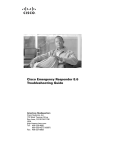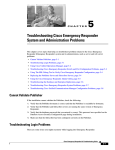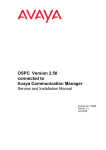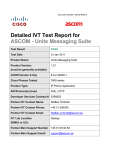Download Troubleshooting Emergency Call Problems
Transcript
CH A P T E R 2 Troubleshooting Emergency Call Problems This chapter covers topics that help you troubleshoot problems related to the routing of emergency calls and the information supplied with the calls: • Emergency Calls Are Not Being Intercepted By Cisco Emergency Responder, page 2-1 • ELIN Not Transmitted To The PSAP, page 2-2 • ELIN For Default ERL Used For Calls From Other ERLs, page 2-2 • Emergency Calls Not Routed to the Correct PSAP, page 2-3 • Emergency Callers Sometimes Get Busy Signal and Emergency Calls Are Sometimes Not Routed, page 2-3 • PSAP Call Back Errors, page 2-4 • Onsite Alert Personnel Are Not Getting Telephone Alerts, page 2-4 • Onsite Alert Personnel Not Getting Email (or Paging) Notifications, page 2-5 • Incorrect Location Information Sent To Onsite Alert Personnel, page 2-6 • Emergency Call History Problems, page 2-6 Emergency Calls Are Not Being Intercepted By Cisco Emergency Responder If Cisco Emergency Responder (Emergency Responder) is not intercepting emergency calls, there is probably a mistake in your Cisco Unified Communications Manager (Cisco Unified CM) configuration or its representation in the Emergency Responder) configuration. • The emergency call number (911) is in the Phone partition and uses the E911CSS calling search space. Ensure this number was identified during Emergency Responder installation (see the Installing Cisco Emergency Responder 8.6 on a New System section in the Cisco Emergency Responder 8.6 Administration Guide). This ensures that users can dial the emergency number. See Creating the Emergency Call Route Points section in the Cisco Emergency Responder 8.6 Administration Guide for information about setting up the Cisco Unified CM configuration for this number. • The standby Emergency Responder server route point (912) is in the E911 partition and uses the E911CSS calling search space. See Creating the Emergency Call Route Points section in the Cisco Emergency Responder 8.6 Administration Guide for information about setting up the Cisco Unified CM configuration for this number. Ensure this number is defined as the standby server route point in the Emergency Responder configuration (see the Installing Cisco Emergency Responder 8.6 on a New System section in the Cisco Emergency Responder 8.6 Administration Guide). Cisco Emergency Responder 8.6 Troubleshooting Guide 2-1 Chapter 2 Troubleshooting Emergency Call Problems • The PSAP callback route point pattern (913XXXXXXXXXX) is in the E911 partition and uses the E911CSS calling search space. See Creating the Emergency Call Route Points section in the Cisco Emergency Responder 8.6 Administration Guide for information about setting up the Cisco Unified CM configuration for this number. Ensure this number is defined as the PSAP callback route point pattern in the Emergency Responder configuration, and that the strip prefix (913) is also identified (see the Configuring Group Telephony Settings For the Cisco Emergency Responder Server section in the Cisco Emergency Responder 8.6 Administration Guide). • All ELIN route patterns are in the E911 partition. See the Creating the Route Patterns for ERLs section in the Cisco Emergency Responder 8.6 Administration Guide for information about setting up the Cisco Unified CM configuration for these numbers. • All phones and CTI ports (both device and line) are in the Phone partition and use the PhoneCSS calling search space. You can use additional partitions, but they must be set up with relationship to the Emergency Responder partitions and calling search spaces in the same manner as these partitions in the examples described in the Setting Up Cisco Emergency Responder to Handle Emergency Calls” section in the Cisco Emergency Responder 8.6 Administration Guide. • All gateways to the service provider network use the E911CSS calling search space. See Configuring the Calling Search Space for the Gateways Used to Connect to the PSAP section in the Cisco Emergency Responder 8.6 Administration Guide. for more information. • The Cisco Unified CM Version (JTAPI jar) being configured is proper. To check the Cisco Unified CM version, follow these steps: 1. Login to the Emergency Responder Admin Utility website. 2. Select Update > CCM Version 3. In the Status section, check the Current Version of CCM. ELIN Not Transmitted To The PSAP If the ELIN is not transmitted to the PSAP, and you are using a PRI connection to route emergency calls to the PSAP, check the configuration of the gateway. The PRI must be configured to send the real calling party number (the ELIN) rather than a static number, such as the main site number. See the Obtain CAMA or PRI Trunks to the PSTN section in the Cisco Emergency Responder 8.6 Administration Guide. ELIN For Default ERL Used For Calls From Other ERLs If an emergency call is assigned an ELIN defined for the Default ERL rather than an ELIN assigned to the ERL whence the call was made: • Check the Cisco Unified CM configuration for the route pattern for the ELIN you expected to be used. See the Creating the Route Patterns for ERLs section in the Cisco Emergency Responder 8.6 Administration Guide. • Check the ERL definition in Emergency Responder to ensure that the ELIN is correctly configured for the ERL. See the Setting Up an Individual ERL and Its Automatic Location Information (ALI) section in the Cisco Emergency Responder 8.6 Administration Guide. If the route pattern for an ERL fails, Emergency Responder uses the route pattern defined for the Default ERL. Cisco Emergency Responder 8.6 Troubleshooting Guide 2-2 Chapter 2 Troubleshooting Emergency Call Problems Emergency Calls Not Routed to the Correct PSAP If an emergency call is not routed to a PSAP, check whether the route patterns used for the ERL from which the call was made and for the default ERL are configured and use the correct partitions and calling search spaces (see the Creating the Route Patterns for ERLs section in the Cisco Emergency Responder 8.6 Administration Guide). Ensure that the partitions and calling search spaces for the gateways are correct (see Configuring the Calling Search Space for the Gateways Used to Connect to the PSAP section in the Cisco Emergency Responder 8.6 Administration Guide). If an emergency call successfully leaves your network but does not get routed to the correct PSAP, look at these possible points of failure: • Is Emergency Responder configured to assign the correct ELIN to the ERL assigned to the phone? Emergency calls are routed based on the ELIN, so if you assign the wrong ELIN, the call is not routed correctly. See the Creating ERLs section in the Cisco Emergency Responder 8.6 Administration Guide. • If the ELIN is correct, is the ELIN route pattern configured to use the correct gateway? If you select the wrong gateway, the call might be routed to a part of the service provider network that cannot connect to the desired PSAP. Consult with your service provider to determine gateway requirements. See these topics in the Cisco Emergency Responder 8.6 Administration Guide: – Setting Up the ELIN Numbers to Route Emergency Calls and Enable PSAP Callbacks – Deploying Cisco Emergency Responder in One Main Site with Two or More PSAPs • Does the service provider ALI database contain the correct information for the ELIN? Emergency call routing outside your network is based on the information in the service provider database, not on the information in your local network. See the Exporting ERL Information section in the Cisco Emergency Responder 8.6 Administration Guide. • Does the emergency caller’s phone register with a Cisco Unified CM cluster supported by a different Emergency Responder group than the Emergency Responder group that supports the originating switch port? Then you might have a miss-configured Emergency Responder cluster. See these topics in the Cisco Emergency Responder 8.6 Administration Guide: – Installing Cisco Emergency Responder 8.6 on a New System – Creating Route Patterns for Inter-Cisco Emergency Responder Group Communications – Configuring Group Telephony Settings For the Cisco Emergency Responder Server Note If the call reaches the PSAP, but the PSAP cannot talk to the caller, ensure that the Cisco Unified CM for the remote Emergency Responder group has the Cisco Unified CM for the local Emergency Responder group defined as a gateway. Emergency Callers Sometimes Get Busy Signal and Emergency Calls Are Sometimes Not Routed If callers hear a busy signal when calling the emergency call number, or if emergency calls sometimes do not get routed, there is probably a problem with the configuration of your standby Emergency Responder server: Cisco Emergency Responder 8.6 Troubleshooting Guide 2-3 Chapter 2 Troubleshooting Emergency Call Problems • If you have only configured a primary Emergency Responder server, install and configure a standby Emergency Responder server. If CPU utilization on the primary server reaches 100%, Emergency Responder cannot handle emergency calls. In this case, the standby server handles the calls. • Check the route point configuration for the standby server. Ensure the emergency call route point call forward settings are configured to forward calls to this number. See Creating the Emergency Call Route Points section in the Cisco Emergency Responder 8.6 Administration Guide for information about the Cisco Unified CM configuration, and the Configuring Group Telephony Settings For the Cisco Emergency Responder Server section in the Cisco Emergency Responder 8.6 Administration Guide for the Emergency Responder configuration. PSAP Call Back Errors You might encounter these problems if a PSAP operator tries to call back an emergency caller using the ELIN provided by caller ID: Symptom PSAP could not reach the original emergency call extension. Recommended Action Emergency Responder caches a mapping between the caller’s true extension and the ELIN you define for an ERL. If more calls get made than the number of ELINs you define for an ERL, Emergency Responder must reuse these numbers and thus overwrites the original caller extension. You can view the call history to determine the extension of the original caller. See the What Happens When an Emergency Call Is Made section in the Cisco Emergency Responder 8.6 Administration Guide. If this is not the problem, check the configuration of the PSAP callback route point in Cisco Unified CM and Emergency Responder (see Creating the Emergency Call Route Points section in the Cisco Emergency Responder 8.6 Administration Guide and the Configuring Group Telephony Settings For the Cisco Emergency Responder Server section in the Cisco Emergency Responder 8.6 Administration Guide), and the ELIN translation patterns in Cisco Unified CM (see the Creating the Translation Patterns for ELINs section in the Cisco Emergency Responder 8.6 Administration Guide). Symptom Onsite alert (security) personnel get callbacks from the PSAP. Recommended Action Emergency Responder routes PSAP callbacks to the onsite alert personnel for the default ERL if ELIN-to-extension mapping for the emergency call has expired from the cache. By default, this is three hours, although you can configure expiration to be a longer or shorter time. See the Cisco Emergency Responder Group Settings section in the Cisco Emergency Responder 8.6 Administration Guide. Onsite Alert Personnel Are Not Getting Telephone Alerts If the onsite alert personnel are not getting telephone alerts when an emergency call is made in an ERL they are covering, ensure that all phones and CTI ports (both device and line) are in the Phone partition and use the PhoneCSS calling search space. You can use additional partitions, but they must be set up with relationship to the Emergency Responder partitions and calling search spaces in the same manner as these partitions in the examples described in the Setting Up Cisco Emergency Responder to Handle Emergency Calls section in the Cisco Emergency Responder 8.6 Administration Guide. Cisco Emergency Responder 8.6 Troubleshooting Guide 2-4 Chapter 2 Troubleshooting Emergency Call Problems Also, ensure that the Emergency Responder configuration for the Cisco Unified CM clusters is correct. The Emergency Responder configuration should show the correct begin address for the telephony ports you defined as CTI ports in Cisco Unified CM, and the number of telephony ports should be the correct number and it must be greater than 0 for a call to occur. Emergency Responder uses this CTI ports to place the telephone calls to onsite alert personnel. If the Event Viewer in the Emergency Responder Serviceability web interface displays the error message “No port to place call,” then there were not enough CTI ports defined to initiate all the calls to onsite alert personnel. Therefore, you must define additional ports. To access the Event Viewer, log in to the Emergency Responder Serviceability web interface and select Tools > Event Viewer. Onsite Alert Phone Does Not Ring When Emergency Call is Placed You might encounter this problem if the onsite alert phone does not ring when an emergency call is placed: Symptom The onsite alert phone does not ring when an emergency call is placed. Possible Cause The onsite alert phone does not ring if the Do Not Disturb (DND) feature is enabled on the phone and if Emergency Responder is configured with Cisco Unified CM 6.x. Recommended Action Do not enable DND on an onsite alert phone. Prompts for Phone Alerts Not Getting Played You might encounter this problem if prompts for phone alerts are not getting played: Symptom Prompts do not get played at the onsite alert phone when the call is initiated from the CTI ports. Explanation This problem can occur when a single CTI port is configured with multiple lines. Prompts may not get played from one or more of these lines when the onsite alert notifications call is initiated through them. Recommended Action To avoid this problem, configure only one line per CTI port in the Cisco Unified CM that is configured for Emergency Responder. Onsite Alert Personnel Not Getting Email (or Paging) Notifications If the onsite alert personnel are not getting email, or email-based pages, even though you configure email addresses for them (see the Onsite Alert Settings section in theCisco Emergency Responder 8.6 Administration Guide), check the Emergency Responder configurations SMTP settings. Ensure that the SMTP server address and source mail ID are correct (see the Cisco Emergency Responder Group Settings section in the Cisco Emergency Responder 8.6 Administration Guide) and that there is an account for the mail ID in the SMTP server. Cisco Emergency Responder 8.6 Troubleshooting Guide 2-5 Chapter 2 Troubleshooting Emergency Call Problems Incorrect Location Information Sent To Onsite Alert Personnel If your onsite alert (security) personnel are receiving incorrect location information for an emergency call, consider these potential problems: • Is the ALI data for the ERL correct? See the Creating ERLs section in the Cisco Emergency Responder 8.6 Administration Guide. • Is the phone location data for the switch port correct? See the Configuring Switch Ports section in the Cisco Emergency Responder 8.6 Administration Guide. • Is the correct ERL assigned to the switch port to which the phone is connected? If not, there could be two problems: – Someone switched wires on the switch, so your formerly correct configuration is no longer correct. Wires cannot be moved from port to port without potentially invalidating the ERL assignment. See the Data Integrity and Reliability Considerations section in the Cisco Emergency Responder 8.6 Administration Guide. – The wiring closet is secure, the ERL assignment is simply incorrect. See the Configuring Switch Ports section in the Cisco Emergency Responder 8.6 Administration Guide. • Did the call come from the Default ERL (assuming you do not use the Default ERL for any permanent ERL)? This could indicate these problems: – The phone is connected to an unsupported port and is not defined as a manual phone. See the Manually Defining a Phone section in the Cisco Emergency Responder 8.6 Administration Guide. – The phone is not supported and it is not defined as a manual phone. See the Manually Defining a Phone section in the Cisco Emergency Responder 8.6 Administration Guide. – The phone is supported but Emergency Responder could not locate it. You might have to manually assign the phone to an ERL if you cannot resolve the problem. See the Too Many Unlocated Phones section in theCisco Emergency Responder 8.6 Administration Guide. • Did the call come from a manually-defined phone extension? If so, it is likely the incorrect ERL is assigned, perhaps because the phone moved. See the Manually Defining a Phone section in the Cisco Emergency Responder 8.6 Administration Guide. Emergency Call History Problems These are some issues you might encounter when viewing the emergency call history information (see the Viewing the Emergency Call History section in the Cisco Emergency Responder 8.6 Administration Guide): Symptom Emergency call information does not show up in call history right away. Recommended Action Emergency Responder writes call history information to the database every 15 seconds. You should be able to view history information after 15 seconds. Symptom The call history does not show the ELIN and route pattern used for a call. If the call could not be routed to the PSAP, you do not see an ELIN or route pattern. Check to determine why the call could not be routed. See the Emergency Calls Not Routed to the Correct PSAP section in the Cisco Emergency Responder 8.6 Administration Guide. Cisco Emergency Responder 8.6 Troubleshooting Guide 2-6

















